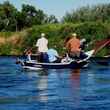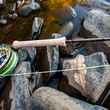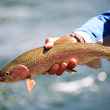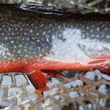Several years back, on an early September day, two fishing buddies and I trekked into a southwest Montana trout stream outside of Ennis, where we spent the day catching pan-sized rainbows, virtually at will.
The day left us spoiled, feeling gluttonous, and as we sat at a bar in town after hiking out to the truck, one of my buddies lifted his mug of amber.
“I bet I caught a hundred fish today,” he said. We nodded. He wasn’t boasting. We probably all did. It was absolute bedlam. It seemed that every cast coaxed a 10-inch wild rainbow to the surface of the creek which gushed down a canyon on its way to its confluence with the Madison. I had to change flies half a dozen times, and not because the flies were ineffective—the trout chewed them down to the thread. “And the best part?” he asked rhetorically. “They weren’t brookies.”
We raised our glasses. To not catching brook trout.
Sadly, that’s the state of backcountry fishing in the West these days. Finding small mountain streams that haven’t been overtaken by ravenous, interloping brook trout is a real challenge (even though, in this case, the stream had clearly been overtaken by non-native rainbows—but that’s a story for another day).
Introduced in the late 1800s all across the West, Appalachian brook trout were the first non-natives planted in the Rockies. According to the U.S. Fish and Wildlife Service, brookies were first planted west of their native range (which extends as far west as Minnesota) as early as 1850. Well-meaning fisheries managers were trying to improve angling opportunity, and, possibly, introduce brookies as a food source as the West slowly opened up for mining and agriculture.
Today, brook trout might be the most prolific invasive salmonid in the West—they are found in every western state save for Hawaii (yes, they were introduced into Alaska between 1917 and 1950).
Brookies are voracious fish that thrive in the cold, clean waters of the Rockies. They do so well that they outcompete native cutthroat trout, and in streams where bull trout are present, brookies can spawn alongside these native char and create a hybrid.
A challenge to native trout reintroduction
While prized in their native range—up and down the spine of the Appalachians from Georgia north to Newfoundland and Labrador, and in the north woods of Minnesota, Wisconsin, Michigan, Quebec and Ontario—brook trout in the West are one of the most pernicious challenges faced by fisheries managers tasked with restoring native salmonids to their historical waters.
Over the years, fish and game agencies across the West have worked, oftentimes unsuccessfully, to remove brook trout from watersheds in order to restore native trout.
Back in the early 2000s, the USFWS was working to return native greenback cutthroat trout to their native ranges in the South Platte and Arkansas river drainages in Colorado—the brook trout was the agency’s greatest nemesis. I visited one particular stream in the upper Arkansas Valley in 2003, where what were believed to be native greenbacks had been stocked after a rotenone treatment to remove brookies. I fished most of the day and I did catch a mess of cutthroats. But, toward the end of the day, I managed to land two 10-inch brook trout, fish that were thought to have been eradicated. Just a few years later, the cutthroats were gone, and the stream had returned to it previous state as an invasive brook trout stronghold.
Brookies seem to have an unparalleled life force—they simply procreate their way to a complete overhaul of native trout waters (and eventually eat themselves out of habitat, forcing their populations to stunt—a four-inch brookie in a Rocky Mountain stream might be sexually mature).
They can thrive in the smallest of mountain streams, and they love habitat that native trout love, too, like beaver ponds and side channels, which can be difficult to effectively treat with piscicides like rotenone or antimycin. Any fish that can nose up into the shallowest waters, or deep into the muck of a beaver pond can survive long enough to outlast the poisonous effects of these chemicals. The simple biological determination of brook trout has been a burr under the saddle for many a fisheries biologist over the years.
A new approach
But, starting in the late 2000s and into the early 2010s, Idaho Fish and Game biologists at the state’s Ashton fish hatchery began considering a novel approach to defeating the brook trout scourge in the West.
Every trout, just like every human, has either male (XY) or female (XX) chromosomes. According to a report published by the American Fisheries Society in 2018, XY male brook trout can be “feminized” by exposing them to estrogen. In a laboratory setting, these feminized XY brookies are then crossed with normal XY male brookies. About a quarter of the offspring from this hatchery experiment will be males, but with two Y chromosomes (YY).
Through continued breeding in the hatchery setting, after a few successive generations, the study achieved its ultimate goal—the first-ever development of a “Trojan” broodstock that is entirely YY—which the Idaho Fish and Game study indicates was “produced in four years at relatively low cost.”
Given that when YY males spawn with normal female (XX) brook trout, their offspring is always male (XY), “these [YY] progeny can then be stocked into wild fish populations and”, over time, “theoretically drive the sex ratio to 100 percent males,” the report reads.
The hope is that an all-male brook trout population will eventually occur, and the non-native fish will simply grow old and die, unable to reproduce due to the absence of females in the system.
Is it working?
In Idaho, introduced male YY brookies are now living in several streams in the Big Lost River drainage alongside wild brook trout. The stocking of the Trojan brookies is also being accompanied by manual removal of non-native brook trout from the target streams with electrofishing—this, in theory, shortens the time it takes to create an all-male population. This is the first time this method has been tried in the wild.
In a hatchery-only experiment conducted in 2017, modeled results suggest that the introduction of male YY brook trout into a watershed could eventually result in the eradication of non-native brookies within 10 years. But the authors of the 2018 study are quick to point out that there a lot of factors at play that make that target timetable somewhat nebulous, including the size of the introduced male YY brook trout, when the hatchery fish come into spawning “ripeness” as opposed to wild fish, and the reproductive fitness of hatchery fish when compared to wild fish.
Biologists have determined that it’s likely more effective to release larger, ready-to-spawn male YY brookies in target streams than it is to release male YY fry into target streams. But that’s also more expensive—it simply costs more to raise fish to spawning maturity over a period of years than it does to simply release fish shortly after they hatch.
In Idaho, biologists determined that catchable-sized YY males introduced into four separate streams did persist long enough to spawn with wild females, and that the offspring of those unions were all males. They remain cautious, however, considering the many environmental factors associated with wild brook trout fisheries, including the tendency for wild brookies to pioneer new reaches of watersheds on their own.
But the results, at least so far, are promising. While it may take time—even a decade or longer—to remove invasive brook trout from a western watershed, there’s hope. It means that, over time, native trout can be reintroduced to their native waters without the challenges of competing with invasive brookies (the watersheds used in the Idaho study were void of trout before being stocked in the early part of the last century, so this isn’t really a consideration in this experimental effort).
As enlightened fisheries managers and anglers continue to push for native trout restoration, this ongoing study provides a source of optimism for the future. Cutthroat trout only occupy about 10 percent of their historic habitat across the West. With any luck at all, and with some patience to let studies like this germinate and produce results, native trout in the West could become much more plentiful.































Comments
Doug replied on Permalink
Thanks for the article. It reminds me of another small stream I fished for grayling. The stream is a tributary of the Big Hole River. While Grayling did come to my flies, the stream was choked with brook trout. I looked down into pools that seemed overloaded with brook trout. I couldn’t help thinking they were out competing the endangered grayling. In that stream, I think those grayling would benefit from removal of the invasive Brook Trout.
Robert. Schneider replied on Permalink
Great idea.would love to see lake trout in yellowstone lake get the yy treatment. Maybe it would be a way to get rid of lake trout in yellowstone and bring back cuts to the lake
Tommy biocca replied on Permalink
Dear Chris,
My name is Tommy, I am an 18 years old biology student from Argentina with special Interest and passion in fish and fishing.
I found this article really original since I have never heard about such experiment; hope this can achieve his aims and be a method to erradicate foreign species where they are not welcome.
I was wondering if I can contact you via Gmail in order to ask you some questions
Hope to hear from you soon
Cheers, tommy
Cole replied on Permalink
Would this not harm the native bull trout populations if hybridization were to arise? Wouldn't the YY chromosome brookies cause all hybrid bull-brook trout to be born male? I believe this could be detrimental to the already fickle bull trout populations. I'm all for the eradication of the invasive brookies for the preservation of the natives, but I think more research should be considered before any mass stockings.
Fred Rickson replied on Permalink
Funny, I never see a piece on “Kill all the brown trout.” Maybe size matters.
Mike replied on Permalink
Better to have Brook trout than no trout, imo! Just catch em, keep ‘em and eat em! Yum!! And what about brown trout….not many seem to want to get rid of them??
And rainbows too? It is very unlikely only Brook trout are the only one of these three which affect Cutthroats? Better to catch 100 Brook trout in a day than no trout!! Sounds like a great day on the waters! Continue with this attempt at poisoning the Brookies and there may be unintended negative consequences that will be regretted!!
RON SMITH replied on Permalink
This is a potentially wonderful development in aiding native cutthroat! It was however interesting that the article starts out narrating of fishing in a Rainbow Trout choked stream. Rainbows are, in my mind, even more dangerous to native Cutthtoat than brookies since they can hybridize with them.
Rick Mai replied on Permalink
HI Chris, just happened to read your 2019 article. I live in the Big Lost range and catch the occasional brookie. Is there a way to physically determine if a brook trout I catch is the YY or not?
Pages